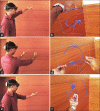Holographic elysium of a 4D ophthalmic anatomical and pathological metaverse with extended reality/mixed reality
- PMID: 35918983
- PMCID: PMC9672738
- DOI: 10.4103/ijo.IJO_120_22
Holographic elysium of a 4D ophthalmic anatomical and pathological metaverse with extended reality/mixed reality
Abstract
Extended reality is one of the leading cutting-edge technologies, which has not yet fully set foot into the field of ophthalmology. The use of extended reality technology especially in ophthalmic education and counseling will revolutionize the face of teaching and counseling on a whole new level. We have used this novel technology and have created a holographic museum of various anatomical structures such as the eyeball, cerebral venous system, cerebral arterial system, cranial nerves, and various parts of the brain in fine detail. These four-dimensional (4D) ophthalmic holograms created by us (patent pending) are cost-effectively constructed with TrueColor confocal images to serve as a new-age immersive 4D pedagogical and counseling tool for gameful learning and counseling, respectively. According to our knowledge, this concept has not been reported in the literature before.
Keywords: 4D Ophthalmology; Cerebral Circulation; Counseling; Extended Reality; Mixed Reality; Pedagogy.
Conflict of interest statement
None
Figures












Comment in
-
Commentary: Opening eyes to the mixed reality metaverse.Indian J Ophthalmol. 2022 Aug;70(8):3121-3122. doi: 10.4103/ijo.IJO_847_22. Indian J Ophthalmol. 2022. PMID: 35918984 Free PMC article. No abstract available.
Similar articles
-
Immersive photoreal new-age innovative gameful pedagogy for e-ophthalmology with 3D augmented reality.Indian J Ophthalmol. 2022 Jan;70(1):275-280. doi: 10.4103/ijo.IJO_2133_21. Indian J Ophthalmol. 2022. PMID: 34937254 Free PMC article.
-
The photoreal new-age innovative pedagogical & counseling tool for glaucoma with 3D augmented reality (Eye MG AR).Eur J Ophthalmol. 2024 May;34(3):870-873. doi: 10.1177/11206721231159249. Epub 2023 Mar 7. Eur J Ophthalmol. 2024. PMID: 36880748
-
Into the Metaverse - Perspectives on a New Reality.Med Ref Serv Q. 2022 Jul-Sep;41(3):330-337. doi: 10.1080/02763869.2022.2096341. Med Ref Serv Q. 2022. PMID: 35980623
-
Augmented and Virtual Reality in Anatomical Education - A Systematic Review.Adv Exp Med Biol. 2020;1235:89-101. doi: 10.1007/978-3-030-37639-0_5. Adv Exp Med Biol. 2020. PMID: 32488637
-
Virtual and augmented reality for biomedical applications.Cell Rep Med. 2021 Jul 21;2(7):100348. doi: 10.1016/j.xcrm.2021.100348. eCollection 2021 Jul 20. Cell Rep Med. 2021. PMID: 34337564 Free PMC article. Review.
Cited by
-
The Metaverse: A New Challenge for the Healthcare System: A Scoping Review.J Funct Morphol Kinesiol. 2022 Aug 30;7(3):63. doi: 10.3390/jfmk7030063. J Funct Morphol Kinesiol. 2022. PMID: 36135421 Free PMC article.
-
Emerging Applications of Augmented and Mixed Reality Technologies in Motor Rehabilitation: A Scoping Review.Sensors (Basel). 2025 Mar 25;25(7):2042. doi: 10.3390/s25072042. Sensors (Basel). 2025. PMID: 40218554 Free PMC article.
-
Assessment of pulmonary vascular anatomy: comparing augmented reality by holograms versus standard CT images/reconstructions using surgical findings as reference standard.Eur Radiol Exp. 2024 May 10;8(1):57. doi: 10.1186/s41747-024-00458-w. Eur Radiol Exp. 2024. PMID: 38724831 Free PMC article.
-
Commentary: Opening eyes to the mixed reality metaverse.Indian J Ophthalmol. 2022 Aug;70(8):3121-3122. doi: 10.4103/ijo.IJO_847_22. Indian J Ophthalmol. 2022. PMID: 35918984 Free PMC article. No abstract available.
-
Commentary: What the eye sees, Let's make the world see - Smart evolution of teleophthalmology.Indian J Ophthalmol. 2022 Dec;70(12):4243-4244. doi: 10.4103/ijo.IJO_2116_22. Indian J Ophthalmol. 2022. PMID: 36453324 Free PMC article. No abstract available.
References
-
- HoloLens 2. [Last accessed on 2022 Jan 14]. Available from: https://medtrixhealthcare.com/holoLens-2blog-post .
-
- Sostel. Eye tracking-Mixed Reality. [Last accessed on 2022 Jan 14]. Available from: https://docs.microsoft.com/en-us/windows/mixed-reality/design/eye-tracking .
MeSH terms
LinkOut - more resources
Full Text Sources

